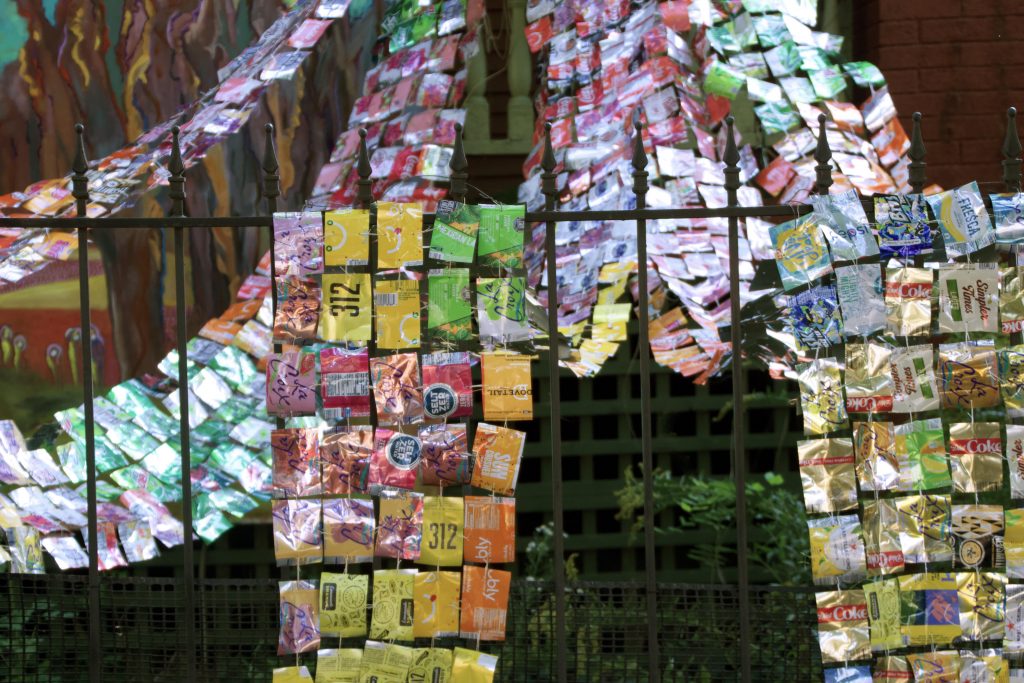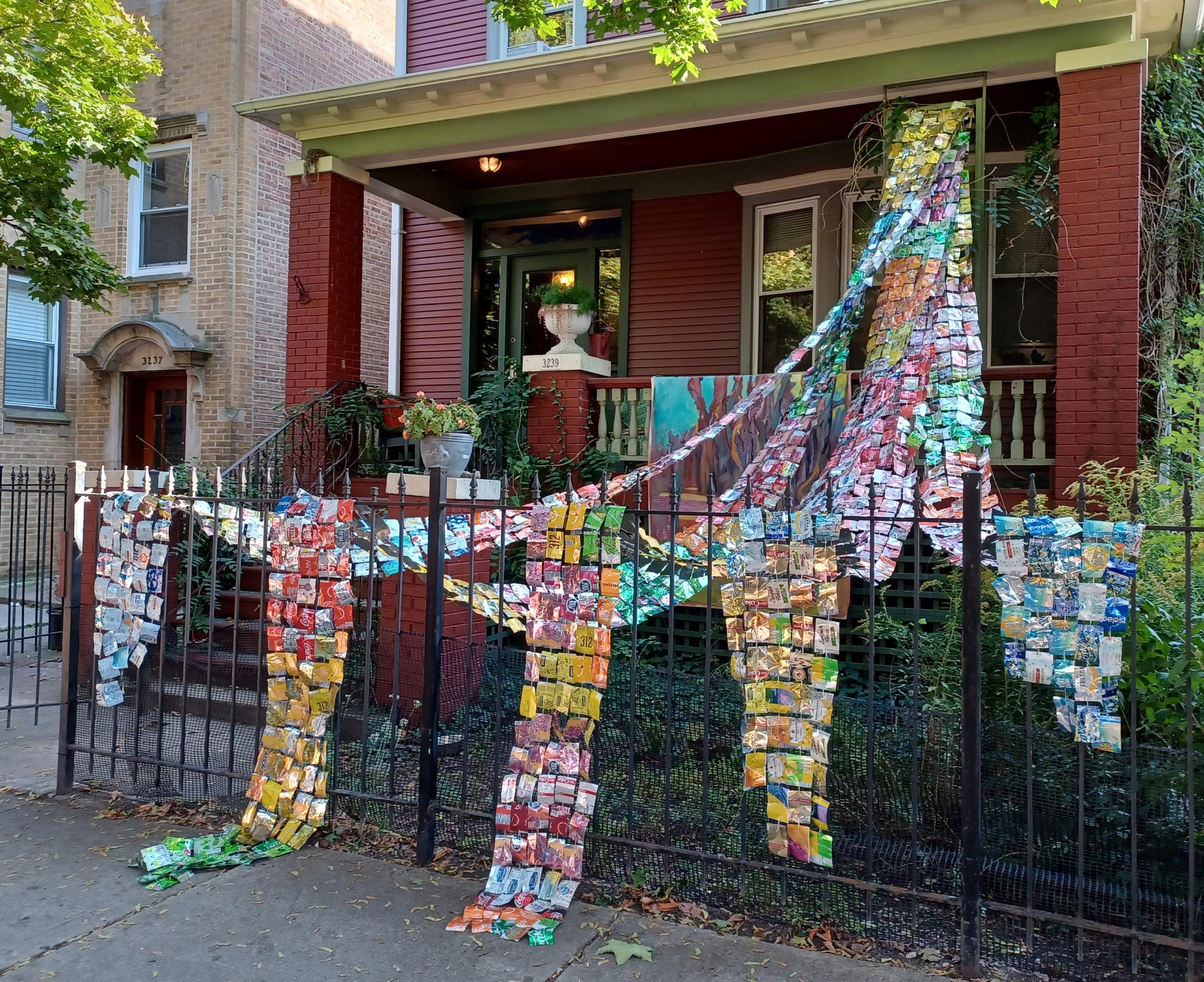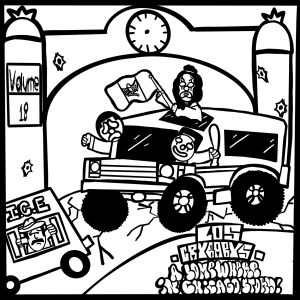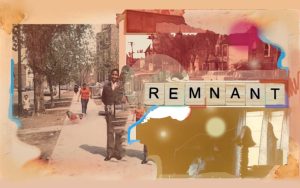Featured image: Laurie LeBreton, “Collective Effervescence,” 2021. 750 aluminum cans and 350 feet of waxed linen twine. Colorful ribbons patterned from cans are draped from the front porch and over the fence. Courtesy of Kitty Goldbert.
Snapshot is a Sixty column that takes a quick look at art history as it happens in Chicago. We send artists and organizers six short and sweet questions to tell us about what they are doing right at this moment. For this feature, we sent a few questions to Laurie LeBreton, one of the many artists included in the Terrain Biennial, an international public art festival on view from October 2 – November 15, 2021. Founded in Oak Park in 2011 by Sabina Ott, the Biennial is an act of radical decentralization, taking art from privileged urban centers and bringing it into everyday spaces. The theme for this year’s Biennial is K.I.T (keep in touch).
Sixty Inches From Center: How did your installation Collective Effervescence come to exist? What was the inspiration or driving force behind its creation?
Laurie LeBreton: Collective Effervescence is the largest installation I’ve ever made, and I’m grateful to the Terrain Biennial for giving me this rare opportunity. I’ve been working on this kind of sculpture for five years, starting with a series called To Honor and Comfort, tapestries made of handmade paper. From the beginning I used exactly the same technique that I used for Collective Effervescence, tying small squares together in patterns. Over the years I’ve added other materials to the tapestries: plastic, fabric, and finally, aluminum cans. Collective Effervescence is the only one made entirely of cans.
I began working on this sculpture in the spring, just as we were coming out of our long COVID winter. I was ecstatic to be outside and to be with other people again. Collective effervescence is a sociological term about this kind of happiness. It describes the joy we feel as a group, a joy that is stronger than what we can feel individually.
I have a friend who says I like anything shiny. She’s exaggerating some, but aluminum cans seemed like a natural material for this work. They are very available, very colorful, and very shiny. Some individual cans are beautifully designed, and that was one more reason I enjoyed using them. It made me even more aware that some of our most basic things can be beautiful. Many artists use recycled materials, but for me the recycling aspect is almost incidental. I use cans because I find them beautiful.

SIFC: What else would you like to tell us about the work?
LL: This was a joy to make. Many people were involved by saving cans, helping to put it together, and helping to install it. I included as many people as I could for the “collective” part and because I needed the help.
SIFC: How did Collective Effervescence come to be installed at this particular home (3239 W. Leland, Chicago, IL)?
LL: I asked Eden Unluata, a graduate school friend, if he had any suggestions for a site for my sculpture. He said, “My friend Colette Adams has the most beautiful porch! Give her a call.” I showed Colette a sample of what I wanted to do, and she loved it. It was all very easy.
SIFC: What mark would you like to leave on your audience?
LL: I always want the work to be joyful, and people tell me it is. The combination of the bright colors, shiny cans, gentle movement in the wind, and the sweet sound of the cans are all very appealing. I also want to take full advantage of my chance to work large, so this is not a timid piece. You almost have to react to it.
SIFC: Were there any challenges in creating the work?
LL: One amusing challenge was getting enough cans. Friends were saving them for me, and that was a good start. It was clear, though, that I would need many more than my friends could provide. Finally, I asked a neighborhood restaurant, Oasis Fresh, if they would save them. Mirsada, the manager, was very enthusiastic and feels some ownership of the piece. She should! I took away large black garbage bags of cans from her restaurant for weeks.
SIFC: How does Collective Effervescence relate to your larger practice?
LL: Collective Effervescence contains signature elements of all my work: bright colors and unusual materials. It also has a spiritual element. For me, making art is an opportunity to connect beyond our day-to-day lives to larger elements and larger ideas. It reminds me that joy is available to us all.






